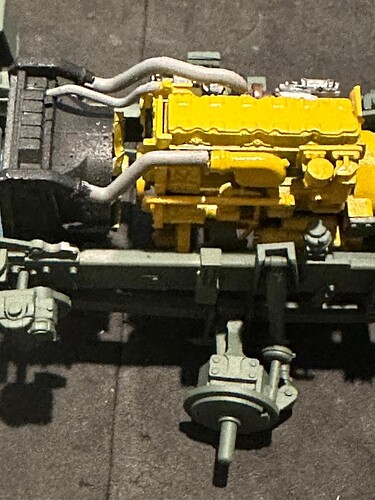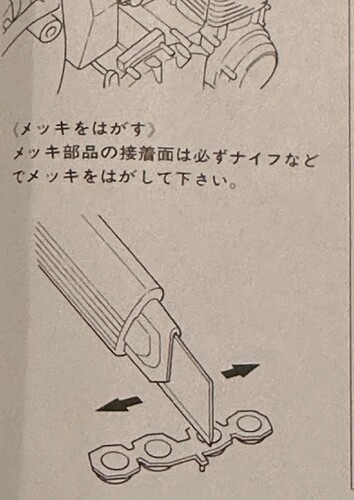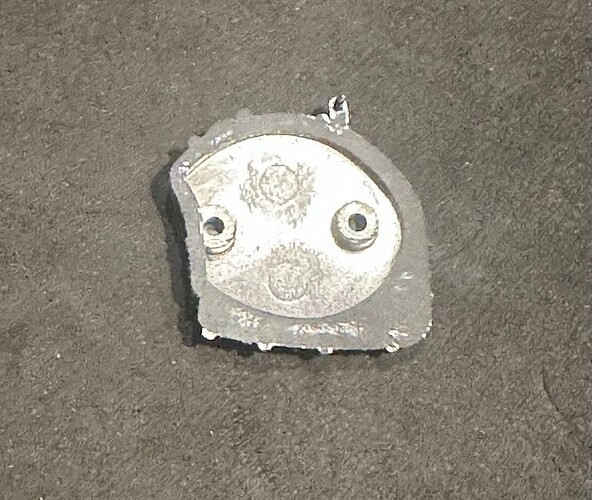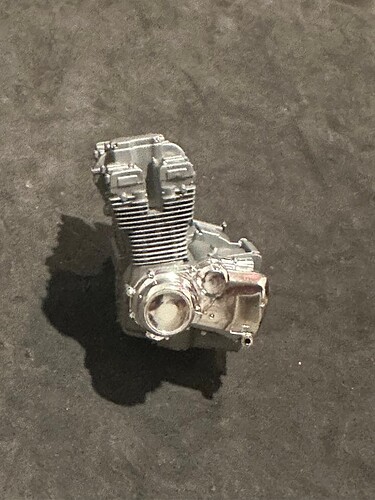A really stupid question, I know.
I’m considering myself as primarily a 1:35 armor “modeler” - so building models made primarily of polystyrene. To the best of my very limited chemistry knowledge the regular modeling cement is actually a solvent that dissolves the surfaces a little bit and then, when pressed together, they kind of “weld”, forming a single piece out of the original two.
Can I use the same cement/technique for already painted elements? My gut feeling says NO, as the surface is already not PS, but the paint itself. Do you use CA glue in such cases? Any help/idea will be welcomed.
I’m using primarily lacquer paints for the “main” job and some airylics for finishing touches, if that matters…
You are correct. The styrene will not bond if it is painted. Also, in my opinion, you are correct that Cyanoacetate (CA - Superglue) is the best way to attach painted parts. Other use epoxy as well.
You can certainly cement painted parts. Way back in the day AMT would tell young modelers in the instructions to scrape away paint (and chrome) before attempting to “glue” parts together. Being of the old school, I still do that when necessary.
The other thing I do is plan ahead. I find out where the attachment points are, and simply don’t paint those areas. If you need to spray a large component, you can use small bits of blue tape to cover the areas where you don’t want paint. This technique works well.
As for CA, yes, you can use it for small things, but you’re still better off scraping off at least a bit of the paint. (also seen in above photo)
CA can and sometimes will pull the paint right off the piece, leaving you with CA and paint that you now have to remove. For tools and things of that nature it’s usually okay, but careless handling can still cause a mishap. The other drawback - the internet is filled with images of instances where you can still see the CA where someone has done exactly that, In fact, there was a discussion right here some months back about that. All you have to do is go back and hit the area with flat clear, but sometimes that step gets neglected.
I would remove the paint from the surfaces where the glue needs to go.
Styrene cements contain various amounts of solvents (I prefer 100% solvent but
that is just my personal preference).
The solvent, depending on concentration, will creep in under the paint and loosen it from
the surfaces (ruining the paint) so cements with solvents in them should not be used
which means CA or epoxy are the available options.
Is it impossible to glue first and then paint and mask?
I only use Tamiya acrylics (?), and other real Hobby acrylics on my models. When gluing (cementing) two parts together, I use either Tamiya thin, or Testor’s, sparingly. The glue dissolves the paint allowing the two parts to join. If necessary, a bit of paint retouching around the joint area.
![]()
![]()
Gorilla Glue will stick to anything, and when it breaks off, the glue will still stick to the paint and it’s the paint that will literally break off of the model kit piece.
NOT a stupid question, especially these days.
CA and epoxy will bond to the paint, not the plastic, and often pull the paint off. This is especially true of true lacquers, some of which bond very well to the plastic, but others not so much. Be wary of the term “lacquer.” These days it is rather loosly used. True lacquers dry, they do not cure like paint. There are also paint-lacquer systems, which you can treat as paint, but may be sold as lacquers. Bear in mind that the label is written by the ad department, not the production, QC, or QA departments (who actually know what they are talking about.)
Some solvent cements will dissolve some paints, especially acrylics, so the bond will be better, but still weaker because the paint contributes nothing to the bond but does contaminate the contact surfaces. Best practice is to mask surfaces that need to bond, or to scrape the paint off with the edge of a blade perpendicular to the surface, called “adzing.”
Not stupid question. I have same. I see lots of you tube videos of people pre priming and pre painting things on sprues still. The cement doesn’t work on painted surfaces well, and it ruins paint around where it is applied. Ca is to me a use as little as possible product because it is so non user friendly in terms of parts and tweezers sticking to fingers, each other etc
Some blades have nice 90-degree edges opposite the cutting edge.
Those work just as good, or maybe even better, than the cutting edge
for scraping. An additional benefit of using the back edge is that the
cutting edge doesn’t go dull so fast.
Scraping really kills scalpel blades …
I would never adz with a scalpel blade—they are too brittle and will break, flying off in a random direction. The backs of some hobby blades, especially the ones where the blanks are stamped out before sharpening, have decent burrs on the back edge that are, indeed, excellent for adzing, though I often find them a little too aggressive. I also keep one knife handle filled with a dulled blade, specifically for lighter, gentler adzing.
The backs of the blades can be adjusted (sharpened/softened)
using a honing stone or diamond file …
In my experience so far, the answer to this question is very complicated. There are a lot of factors that influence the best way to reach the goal.
Things that will affect the problem:
- The way parts are designed to attach to the model.
- The location of the parts on the model.
- The amount of contact surface available between the part and rest of the model.
- When in the construction process the part must be painted and attached.
- The paint scheme you will apply to the model.
- How surrounding paint colors contrast with one another.
- The type of paint you are using.
- The type of glue you are using.
- How the model will be handled.
- When attaching in advance, how difficult it is to get at the part after priming and spraying camouflage.
- When applying complex camouflage, how difficult will it be to work around an attached part.
- The relative complication of the part.
- How much effects painting you intend to put on the part.
- How much effects painting you intend to put on the model.
- How steady your hands are.
- The fragility of the model, the part, and surrounding parts.
- How good you are at picking out a detail with a fine point brush.
- How easy it is to mask the area where a part attaches.
- When to attach a part in the construction and painting process.
- More stuff I am forgetting.
As an example, I recently realized it is a bad idea to glue down tow cables along their entire length. If they are loose along most of the run, it is easy to slip paper under the cable and paint it after the fact. This also achieves a more realistic result. Little stuff like that comes up constantly.
As another example, let us say you build a complex jack. You want it to look heavily used. If you attach it before priming and painting camouflage, you will need to carefully paint the entire thing, then do all the effects painting on the model without marring the surrounding surface. If you paint it separate, you need to glue the mounting hardware in place after the fact, and that means risking a glue problem. Which is right?
How about periscopes. Do you mount before and paint after? Do you paint separate and attach after? How do you get the periscople in place after the fact if the mounting hole is really hard to get to?
In my relatively short experience there is no one answer to these questions. Often times, I try something and see if it works. If yes, keep doing that. If not, don’t do that again.
Wow. That has more variables than the quadratic equation.
Me- I don’t like to think that hard when I’m decompressing.
My rule regarding paint is simple:
It’s a simple matter to remove paint. And chrome. As I’ve said before, wanting to save a few seconds by using CA instead of putting in the work is more often than not going to end up being less than optimal.
Even Tamiya shows what to do in their instructions:
For the record, I have never gouged plastic using a blade, and usually use the wider portion, which even if it did get a little dull is rarely ever used for cutting.
Of course there are always options. I used a fine file for this part - if it weren’t for the pin in the way I could just as easily have swiped it back and forth a few times on some very fine wet/dry paper:
Doing things right the first time always works for me.
Indeed!
It’s like high school kids spending more effort on figuring out how to cheat at tests instead of learning the subject …
Well said.
Above photo showed removing chrome before assemlby. This one shows not painting an area you don’t want painted:
Which is why I don’t readily embrace AI in the classroom as many of my peers have, as now I have to spend time running constructed responses through a checker to be sure the student answered the question and not a bot scanning Reddit.
Blu-Tac or another masking putty for mating surfaces, and for things like mounting holes, I will usually stick a toothpick firmly into the hole to keep the paint spray from getting down into the hole, so that there will still be a plastic-to-plastic surface to bond.
However, once the parts/subassemblies are painted, the trick of fitting the parts together and touching a Tamiya Extra Thin applicator to the joint to let capillary action wick the glue into the joint won’t work, because it will craze the paint around the joint (found that one out through sad experience), so you have to apply the cement to whichever of the pieces you have clear access to the mating surface of.






